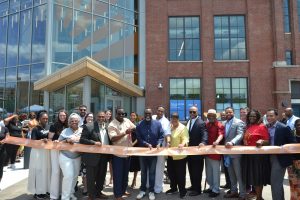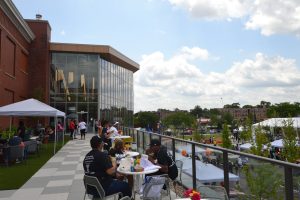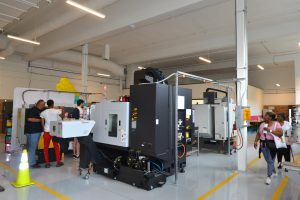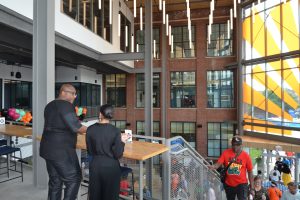Chicago West Side workforce development center opens
By Igor Studenkov for Chronicle Media — July 24, 2025
Elected officials and nonprofit leaders prepare to cut the ribbon for the new Aspire Center for Workforce innovation. (Photo by Igor Studenkov/for Chronicle Media)
As Aspire Center for Workforce Innovation, the new workforce development and social services hub at the heart of Chicago’s Austin neighborhood, opened on Juneteenth, June 19, elected officials and leaders of nonprofit organizations didn’t shy away from the controversial decision the city made over a decade ago that paved the way it.
Emmet Elementary School at 5000 W. Madison St. was among the 50 Chicago public schools that were closed in 2013, something that the Chicago Public Schools District attributed to declining enrollment. At the time, advocates such as Dwayne Truss, who went on to serve as Chicago Board of Education member during mayor Lori Lightfoot’s administration, argued that schools such as Emmet were never given the resources to live up to their potential, which fed into declining enrollment.
In 2018, Westside Health Authority, a longtime Austin-based social service organization, purchased the building, with the intention of consolidating workforce development and most other services in one location, while also offering space for other West Side nonprofits and other organizations that shaded its goals. The Austin Coming Together coalition came on board first, with other entities joining in later. While the plans ran into several delays, it officially opened in June.

Chicago Mayor Brandon Johnson said that the shutdown of Emmet School was a mistake — and the opening of Aspire Center as an opportunity. (Photo by Igor Studenkov/for Chronicle Media)
During the grand opening celebration held at the Aspire Center lawn, Mayor Brandon Johnson and several other officials described Emmet school’s closure as a tragedy. But they also described Aspire Center as proof that not only is development possible in communities like Austin, which faced chronic disinvestment, but that it could be spearheaded by local, Black-run organizations.
By the time of the grand opening, Aspire Center services were mostly up and running. WHA moved all of its services except family services to Aspire Center, which means that they can help clients get housing, find childcare, get jobs and get their criminal records expunged under one roof.
ACT moved its headquarters to Aspire Center, and it is helping West Siders connect to social services and workforce development programs. Jane Addams Resource Corporation job training nonprofit moved its advanced manufacturing job training program to Aspire Center, and BMO Harris bank set up a branch that will also offer including financial literacy classes and other business support services.

Aspire Center’s second-story outdoor patio is open to the public when the weather allows. (Photo by Igor Studenkov/for Chronicle Media)
Aspire Center also has a coffee shop like public seating area on the second floor that residents can use during the building’s regular hours to work, make calls or simply hang out. A conference room is available to West Side organizations on first-come/first-served basis in the morning and by reservation in the afternoon.
While WHA still owns the building, it and ACT set up a nonprofit entity to manage Aspire Center’s day-to-day operations. It isn’t entirely separate — WHA CEO Morris Reed and ACT executive director Darnell Shields sit on its board — but it isn’t directly controlled by either entity.
Aspire Center interim director Natalie Goodin said that her organization is responsible for developing and coordinating services, building on what the nonprofits are already doing.
When discussing plans for Aspire Center last fall, Shields told Chronicle Media that they still weren’t sure what would happen to the building’s third floor. The tentative plan, he said at the time, was to set up a business incubator or something else that can “bring services and complement” Aspire Center’s mission.
Goodin told Chronicle Media that, as of June 19, Aspire Center still “didn’t have a formal plan” for it.
“We are about to begin a long process to figure out what that would look like,” she said.

Inside the JARC advanced manufacturing training area. (Photo by Igor Studenkov/for Chronicle Media)
During the grand opening ceremony, Shields described Aspire Center’s opening as a testament to the Austin community’s power to change things for the better in the face of adversity, its “refusal to settle for anything less than excellence.”
“When the doors of Emmet School closed, many in the Austin community felt the sting of loss,” he said. “It was a heartbeat of this community. But there was always faith in the unseen, faith in what it could be. And today, that faith has become a reality.”
Shields described the Aspire Center as “a symbol of hope when people come together, when the community doesn’t give up” and a place where “someone walks in unsure of their future, and steps out with a new job, and a new career and a new life.”
“Today, we are no longer victims of disinvestment, we are the victors in the fight for justice and healing,” he said. “Let’s reclaim what was lost, reimagine what was lost and rejoice in the moment we have together.”
Reed noted that Aspire center is part of the wave of new development Austin has seen in the last few years, mentioning the Broader Urban Involvement and Leadership Development youth services nonprofit’s new, larger headquarters, the new By the Hand Club’s North Austin campus, and the renovation of the old Catalyst Circle Rock charter school auditorium into the Kehrein Center For The Arts.

The public work area at the Aspire Center. (Photo by Igor Studenkov/for Chronicle Media)
Reed said that the architects that renovated the Emmet School mentioned that the building “got good bones.
“That resonated with me, because Austin has good bones,” he said. “We gotta stop giving up on it.”
Cook County Commissioner Tara Stamps, D-1st, a former teacher, reflected African Americans had to struggle to get education since slavery, which is why the 2013 schools were “a stab wound, a gunshot to a hope of a slave.” But Aspire Center coming out of it represented “the hope of our ancestors.”
“We must participate in our own rescue,” Stamps said. “It is an honor to be here today in support of a vision that’s becoming a reality. It is more than brick and mortar — it is a promise kept for a community that has been waiting for investment for too long.”
Ald. Chris Taliaferro, 29th Ward, whose ward includes the Aspire Center site, Kehrein Center and the new BUILD headquarters, said that these and other developments were only possible because people believed that in Austin’s potential.
“We are able to look up and hope,” he said. “We are a community that’s growing.”
Mayor Brandon Johnson, who lives in Austin and, like Stamps, is a former teacher, was the last to speak. He decried the closure of 50 schools in general and Emmet specifically as “a violent act against the Black people.” And while Aspire Center doesn’t diminish it, he said, it represents a step forward.
“We not only busted this door wide open, but we created opportunities for posterity,” Johnson said.







